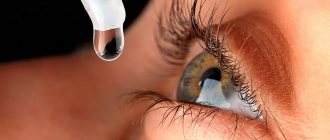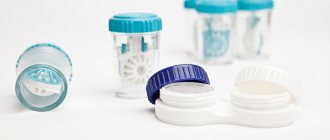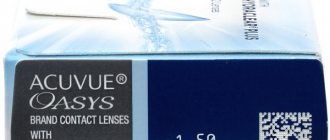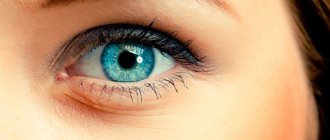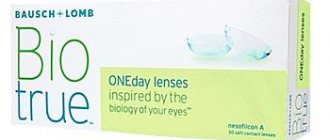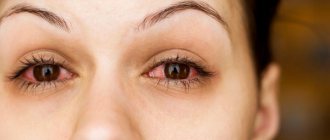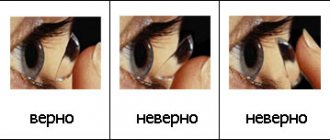The creation of contact lenses has long forced many to give up wearing glasses and give preference to these invisible and convenient vision correctors. But they have a significant disadvantage: they need to be cleaned regularly and not allowed to dry out. The main attribute for safe wearing is the choice of a special solution.
Share
Tweet
Share
Cool
Send
What is the purpose of lens solution?
Lens solution is necessary for treating ophthalmic products designed for long-term use (two-week, monthly, quarterly and traditional lenses), because during the day various contaminants that come from the environment and organic deposits that are part of the tear fluid accumulate on their surface. The listed factors negatively affect the optical properties of lenses. Over time, they may become cloudy, and as a result they will not provide high-quality vision correction.
In addition, protein and lipid deposits can lead to the development of allergies. There is redness of the eyes, the appearance of irritation, itching and a burning sensation. Wearing lenses with such symptoms becomes simply impossible. Such deposits can serve as a favorable environment for the development of bacteria, and if contact optics are not treated, the risk of developing eye diseases of infectious origin increases. The most commonly diagnosed pathologies are acanthamoeba keratitis, conjunctivitis, and blepharitis. During the treatment of these diseases, it is recommended to stop wearing contact lenses.
Therefore, we can confidently say that the main task of solutions for lenses is to clean their surfaces from dirt and deposits, as well as disinfection. In addition, cleaning liquids help extend the life of products, because they are used to store them after removal and until the next use. Considering the fact that 2/3 of the lenses consist of water, they should never dry out, because their use in this case can be dangerous. It is in this situation that solutions that have the ability to have a moisturizing effect will come to the rescue. Their use helps make wearing ophthalmic products more comfortable.
The functionality of the solution depends on its constituent components. When choosing a solution for lenses, you need to consider:
- type of ophthalmic optics;
- indications;
- financial solvency;
- personal preferences.
Silicone hydrogel lenses
Hydrogel contact lenses are gradually being replaced by innovative developments. Silicone hydrogel CLs have practically eliminated the problem of oxygen starvation, since they allow enough oxygen to pass through. The optics allow 6 times more oxygen to pass through than the hydrogel.
This ensures normal metabolism and prevents oxygen starvation.
Advantages:
- high level of comfort during wearing;
- the organs of vision are not subject to dehydration;
- suitable for drivers, people working with computers and people who work in areas with increased dust or dryness;
- lead to a significant reduction in limbal hyperemia;
- the use of disinfectant compounds and moisturizing drops does not affect the condition of the surface of the product created as a result of plasma treatment.
Wearing mode: flexible, extended and daytime. Sometimes you can leave the lenses in overnight. Extended wear products can be left in place for 7 days.
Moisture content level up to 45%. There is no need to use moisturizing drops.
Best product samples:
- Johnson&Johnson 1-Day Acuvue TruEye;
- ClearLux One Day Aspheric;
- Air Optix for Astigmatism;
- PureVision 2;
- Biofinity XR.
Minuses
Silicone hydrogel lenses are not without their disadvantages. Silicone contained in the optical product may cause allergic reactions. Causes redness, irritation, burning and itching in some users.
The optical product is resistant to the accumulation of fatty deposits. But protein deposits accumulate. Silicone hydrogel lenses are cleaned daily. For beginners who have previously used conventional optics, silicone hydrogel products may seem harsh.
Adaptation is quick, discomfort goes away after 2-3 applications. For silicone hydrogel CLs, it is necessary to use an appropriate multifunctional solution. Incorrect selection of fluid leads to relatively asymptomatic staining of the cornea. Maximum staining occurs after 2 hours, decrease occurs after 6 hours.
What solutions for lenses are there?
Optical ophthalmic products in ophthalmology are usually divided according to the State Clinical Committee into three groups, they are:
- Multifunctional. They are easy to use and may have moisturizing properties. Can be combined with all types of lenses or with hydrogel or silicone hydrogel. Their use often causes concern among patients, because they contain preservatives. However, there is no need to worry, because preservatives can also be beneficial.
- Peroxide. The positive thing is that they do not contain preservatives and have a disinfecting effect on contact lenses. However, they do not contain moisturizing ingredients and are more difficult to use. That is why before using peroxide solutions it is recommended to carefully read the instructions for use.
- Universal. Can be used on any contact lens and includes all peroxide cleaning systems and some multifunctional ones.
Detailed characteristics of solutions for contact lenses
Peroxide systems
Peroxide solutions are made on the basis of such a well-known antiseptic as hydrogen peroxide. Their use ensures disinfection of contact optics, because solutions have the ability to have a detrimental effect on all types of pathogenic microorganisms. Due to the fact that they do not contain preservatives, they can be used even by allergy sufferers.
Such solutions are divided into two types - with a one-stage and two-stage cleaning system. The most common nowadays are the first type of cleaners. They come with a container that contains a built-in platinum catalytic disc that serves to neutralize hydrogen peroxide. The main active ingredient of the solution should not get into the eyes, as it can cause irritation.
The lenses are attached in a special device, which is placed in a container with a solution. Within 4-6 hours they are completely cleaned and disinfected. There is no need to rinse the lenses before putting them on.
If we talk about a two-stage lens cleaning system, then it becomes necessary to rinse them with saline solution before putting them on.
Peroxide solutions are suitable for almost all types of lenses, the only exception being colored ophthalmic products. This is explained by the fact that peroxide has the ability to destroy and wash out color pigment, leading to a deterioration in the decorative properties of lenses.
The main disadvantages of peroxide solutions are:
- the risk of damage to contact optics with a high level of moisture when stored in solution for a long time;
- the need for a long period of time for effective lens processing;
- inconvenience during transportation when there is a need to be on the road for a long time.
Enzymatic lens cleaners
Enzyme solutions and tablets are used for deep cleaning of protein-based contaminants. They are not able to replace peroxide and multifunctional cleaners; they are usually used along with them.
It is recommended to carry out treatment once every 7-10 days, that is, their use is considered justified when wearing monthly, quarterly or traditional lenses. They should not be used for colored lenses, because they, like peroxide solutions, provoke their discoloration.
Multifunctional lens solutions
The solutions got their name due to the fact that they are endowed with the ability to perform several functions. They are considered the most popular, because they are suitable for processing almost all optical ophthalmological devices and do not cause adverse reactions.
The advent of silicone hydrogel material was a revolutionary discovery. Before this, everyone relied on hydrogels, finding them excellent. But as soon as products made from silicone hydrogels entered the market, the leadership was immediately transferred to them.
Even an experienced user, not to mention specialists, will mention their advantage - they are highly gas-permeable. One of the most outstanding lenses in this regard are the contact correction products “AirOptix Night & Day” produced by “CIBA Vision” and “Pure Vision”, which have already been developed by .
What is remarkable about them that gave them a high rate of gas permeability? He gave birth to continuous wear lenses. That is, oxygen reaches the cornea so well that you can sleep in the lenses not just one or two nights, but thirty. It is possible, yes, but is it necessary?
Some ophthalmologists are inclined to believe that this is acceptable, others are wary, but the eyes will not rest from the lenses for a month. If we take the general opinion that we managed to form, that a continuous thirty-day wearing regime is acceptable, but only when really necessary, for example, when doing mountaineering, when a person will not be able to remove contact optics for many days while in the mountains. The second condition for continuous wearing is the absence of contraindications. The approval of an ophthalmologist or optometrist is mandatory in this case.
Step by step, silicone hydrogels have gained ever larger market share. They could offer patients not only continuous wearing, but also other advantages, which clearly looked like a convincing advantage, and not a debatable issue. Patients who knew from experience what contact correction was, abandoned lenses made of other materials in favor of silicone hydrogel. Growth cannot be ignored.
Statistical studies have shown that in 2000 in Great Britain, silicone hydrogels were purchased in 3.6% of cases, but a year later the percentage increased to 12. Moreover, these were not just silicone hydrogels, but contact optics made from them and having continuous wearing mode.
In 2001, 65% of industry specialists prescribed silicone hydrogel eye lenses to patients, while a year ago the percentage of such ophthalmologists stopped at 37. The difference is enormous, and in just one year.
Silicone hydrogels have captivated the hearts of both users and optometrists and ophthalmologists. Patients note comfort as the main advantage of these lenses in any wearing mode. Ophthalmologists - safety, prevention and prevention of the development of corneal hypoxia. There is enough oxygen to avoid such problems.
Even beginners, when removing silicone hydrogel lenses, do not feel tired, their eyes are not red, they practically do not require adaptation, and the concept of dry eyes or ordinary discomfort is alien to them. Would you really refuse this?
The transition to silicone hydrogels is justified by many factors, but this transition should be done slowly. The fact is that new lenses require new cleaning products. How can silicone hydrogels be cleaned with a solution that is being developed early, before they appear, with a solution that targets hydrogels? This will lead to completely unnecessary complications.
Therefore, when changing lens material, you need to think about its compatibility with the care product. This is not difficult, because you need to buy solutions for both hydrogels and silicone hydrogels, it’s just that the solutions themselves will be different.
Which solution is better
In order to choose the correct and most suitable solution, it is necessary to select it together with an ophthalmologist. Otherwise, there is a risk that the solution will not work and will lead to eye irritation, the development of allergic reactions and even complications. The doctor takes into account the individual characteristics of the eyes and even the entire body of his patient.
When choosing a solution for lenses, you need to pay attention to:
- Compound. Solutions containing hyaluronic acid, patented cleansing agents, moisturizing complexes, and harmless preservatives require attention.
- Bottle volume. If the solution will be at home, it is better to choose a large bottle size, but if you have to travel with it, a container with a capacity of 60-100 ml is better. However, you can purchase a travel kit that will contain bottles into which you can pour the solution from a large bottle.
- Availability of container. If it is not available, you will have to order it additionally, because you will have nothing to store the lenses in.
It is necessary to emphasize that the high price of a product does not always correspond to the quality. To make the right choice, it is recommended, first of all, to pay attention to the composition of the product. The best option would be to consult a doctor.
Rating of the best solutions for lenses
When compiling a rating of solutions for lenses, we listened not only to the opinions of experienced ophthalmologists, but also looked at the reviews of ordinary customers. The TOP included ophthalmic liquids for sensitive eyes and hard optics, as well as multifunctional moisturizers.
When selecting rating participants, we paid attention to the following characteristics:
- Type of solution;
- Effectiveness of action;
- Safety;
- Quality of cleaning;
- Price;
- Amount of preservatives in the composition;
- Availability of a new container included;
- Contraindications;
- Duration of effect;
- Degree of tolerance;
- Is it suitable for sensitive eyes.
The best budget solution for lenses from the rating we compiled is the Russian-made solution “Likosol-2000”.
For a modest price, the buyer receives a multifunctional solution in a compact 60 ml bottle. The most expensive option is Solo Care Aqua. However, its characteristics are much more varied, and it comes with a new, replaceable silver-plated container.
The best drops for conjunctivitis
Rules for using contact lens solution
To reduce the risk of developing undesirable reactions and negative consequences from the use of solutions for optical ophthalmic systems, it is recommended:
- store the solution in a tightly closed bottle;
- do not use products that have expired;
- treat lenses after removing them, and not before use;
- disinfect the lens storage container using the same product as for treating lenses;
- Manipulate the bottle with the utmost care, making sure not to touch its neck.
By adhering to such simple rules, you will be able to protect yourself from the development of such troubles as CL rejection, allergies, a feeling of discomfort, and infection on the mucous membrane of the eyes.
How to choose the right lenses
Let's start with the fact that independent choice of lenses is excluded. The selection of correction means should be carried out by an ophthalmologist or optometrist. However, you can voice your wishes, which the specialist will definitely listen to.
Selection of materials
Today, hydrogel and silicone hydrogel lenses are especially common. Both types are soft and comfortable, and the choice depends on the reasons causing increased sensitivity.
For example, it is better for patients with chronic dry eyes to use silicone hydrogel lenses - they have a higher breathability index, which can reach up to 170 DK/t, while for hydrogel lenses this figure is on average only 20 DK/t.
However, the silicone component of the material can in some cases cause an allergic reaction. Therefore, doctors prescribe hydrogel lenses to patients prone to allergies. To avoid dryness when wearing, the ophthalmologist selects moisturizing drops.
Type and mode of wearing
Ophthalmologists do not recommend that patients with eye sensitivity stay in lenses overnight. If you have any pathologies, it is better to limit the time you use contact lenses to 8-9 hours.
Patients with hypersensitivity may be prescribed one-day, two-week and monthly lenses
Daily lenses are considered the safest - they do not require maintenance, lipid deposits do not accumulate on them, and the patient puts on a new pair every morning. Therefore, they are considered the most comfortable, since they do not lose their moisturizing qualities by the end of their use.
Next come two-week lenses; they are also able to retain their moisturizing properties for a long time. In addition, after two weeks of use, a large amount of lipid and protein deposits do not have time to accumulate on the lenses. The only downside to two-week lenses is that they are not the most comfortable wearing mode. Unlike monthly lenses, which need to be changed on a specific date, and one-day lenses, which are changed every day, patients may forget about timely replacement of two-week lenses.
Monthly lenses are the least safe for people with highly sensitive eyes. Even with regular and high-quality care, deposits accumulate on the lenses. If the patient has pathological conditions of the visual organ, deposits can cause inflammation. However, the use of monthly lenses is still acceptable. However, the ophthalmologist must select a model with the best indicators of oxygen permeability and moisture content.
Solutions for lenses in pharmacies in Moscow and Odintsovo
You can choose the necessary product not only by visiting the pharmacy yourself, but also via the Internet, using online services. The Aptstore pharmacy chain offers its customers a wide range of high-quality medical products. It is developing at an unstoppable pace, and there are already several dozen pharmacies in Moscow and several in Odintsovo. However, the pharmacy chain does not plan to stop there; in the near future, it is planned to open new locations throughout the country.
Thus, the pharmacy chain is trying to become close to every person, bringing maximum benefit. Due to the fact that Aptstore branches are located in almost all districts of Moscow, they are accessible to all segments of the population. You can choose the product you need not only by visiting the pharmacy yourself, but also by using the online service.
Solutions have become better
In recent years, contact vision correction has seen a shift towards the use of maintenance-free daily disposable lenses, which have reached 38% of the soft contact lens market. This trend even affects segments of lenses with complex design - toric and multifocal. Nevertheless, the shares of lenses for scheduled and frequent scheduled replacement are still very large (42 and 14%, respectively), and they are not going to lose their positions. This means that lens care products will continue to play an important role in the lives of many soft contact lens wearers.
Care products, such as multifunctional solutions (MFR) and peroxide systems, are subject to very strict requirements from authorities responsible for the quality and safety of the use of medicines, food products and other products that directly affect human health.
And these measures are completely justified, because in the memory of many who wear contact lenses, cases of outbreaks in different countries of the world of such a dangerous eye disease as microbial keratitis, caused by the use of solutions with an insufficiently effective disinfection system, are still fresh. Those not so distant events forced manufacturers to reconsider their understanding of what a truly safe care product should be. The composition of the products, which were once considered such, has been carefully checked and refined in order to avoid the mistakes of the past. In addition, many new soft contact lens care products have been released that meet even higher standards of safety and comfort.
Pros of buying contact lenses online
Purchasing medicines and medical products through an online store is becoming increasingly popular. The main advantages of such purchases are:
- the opportunity to thoroughly familiarize yourself with the characteristics of the products;
- availability of time to evaluate the correctness of the choice;
- the opportunity to save money, because you can find promotional offers and discounts;
- guarantee that the required product will wait for the owner at the pharmacy.
How to order lens solution from a pharmacy online
First of all, you need to go through the registration procedure. You must enter your contact information, after which a personal account will be created in which the order will be displayed and stored if it is added to the “Favorites” section. Using the “My Pharmacies” button, you can save the addresses of pharmacies located most advantageously to your home or work.
After registering, you can proceed to shopping, add the selected product to your cart and click the “Place an order” button. After this, the buyer receives a message with information about the order. If the product is delivered from a warehouse, you must wait for an information message about its delivery to the pharmacy and its readiness for pickup, this will take about 3 days
In an online pharmacy, you can see two prices next to the product, one indicates the cost when purchasing from stock, the other - when ordering from a warehouse.
Is Optimed Lens Solution safe for your eyes?
The modern market offers various multifunctional solutions that are suitable for all types of lenses. Among them, Optimed especially stands out, but how safe is it for the eyes? Let's figure it out.
Lens solution is a disinfectant that is used to clean and store lenses. It is recommended to select it or buy a new one only after consulting a doctor, since otherwise you risk harming the health of your eyes. For example, if you have been using a certain brand for a long time and then suddenly decide to change, you may have an allergic reaction to any new components in your body. That is why the issue of its correct selection should be taken as seriously as possible. One of these cleaners is Optimed, which is produced in Russia.
It is available in four variants:
- Optimed Proactive Lens Solution;
- Optimed Plus Lens Solution;
- Optimed Comfort Lens Solution;
- Optimed Light lens solution.
Proactive is a universal product that can rinse, clean, disinfect and moisturize them well, while maintaining their original shape. It is especially suitable for sensitive eyes, since it contains succinic acid, which provides the necessary oxygen access to the cornea of the eye.
The next option is Optimed Plus. It should also be used for cleaning and storing contact vision correction products. The formula of this cleaner quite carefully cleans their entire surface. An optical product that has been in it for about five hours will completely get rid of all protein deposits and minor contaminants, so its subsequent wearing will be completely safe for your eyes.
The Comfort cleaner is also quite effective. It contains an antiseptic component - gamma-myristin, which has an antifungal effect. However, it must be used with extreme caution in patients with sensitive eyes.
The last cleaner I would like to talk about is Light. It is available in two volumes: Optimed Light lens solution 250 ml and 125 ml. Its use is especially indicated for those people who wear lenses constantly. It contains sodium hyaluronate, which maintains the necessary moisture, making them comfortable to put on and wear.
MagazinLinz.ru team
